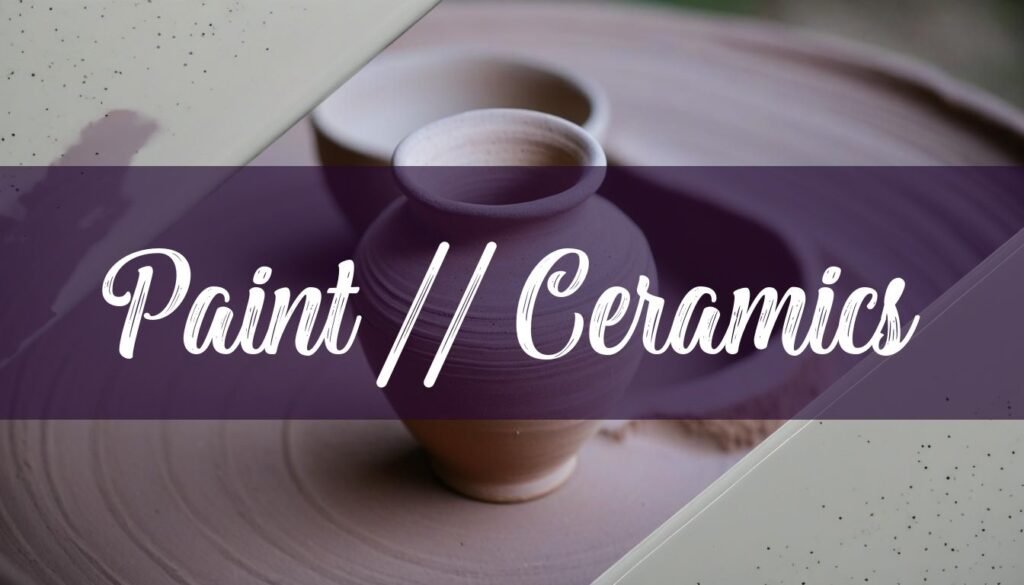Painting ceramics is a delightful way to express your creativity and create personalized pieces. Whether you’re a seasoned artist or a beginner, the location you choose for your ceramic painting project can significantly impact your experience and the final product. Let’s explore various options, weighing the pros and cons of each to help you find the perfect fit for your needs and aspirations.
Exploring Different Ceramic Painting Locations
One popular option is the dedicated paint-your-own-pottery studio. These studios offer a social and creative environment where you can relax and let your imagination run wild. The beauty of these studios lies in their accessibility; they provide everything you need, from a wide selection of bisque (unfinished ceramic pieces) to an extensive range of paints, brushes, and tools. Moreover, they handle the glazing and firing process, which is crucial for making your painted piece food-safe and durable. The cost typically includes a studio fee plus the price of the ceramic piece you choose. The all-inclusive nature of these studios makes them an excellent choice for beginners or those who prefer a hassle-free experience, and remember the social aspect provides inspiration.
However, painting ceramics at home offers convenience and cost-effectiveness. You have the freedom to work at your own pace and in your own space. The initial investment involves purchasing ceramic paints, brushes, and a sealant if you’re working with air-dry clay. Acrylic paints are generally recommended for unglazed pottery, while porcelain paints are suitable for glazed surfaces. Keep in mind that if you want to fire your pieces for a more durable and food-safe finish, you’ll need access to a kiln, which can be a significant investment. For those without a kiln, air-drying acrylic paints are a viable option, though the finished product won’t be as durable or washable as a fired piece. For those interested in learning more about the process, you might want to check out this guide on how to glaze pottery for beginners. Additionally, it’s worth exploring how to paint your own plates, for added ideas.
Community centers and art schools also provide opportunities for ceramic painting. These institutions often offer classes and workshops that provide structured guidance and learning opportunities. This option is particularly beneficial for beginners who want to learn specific techniques or receive feedback from instructors. The cost varies depending on the length and intensity of the course, but it’s generally more affordable than setting up your own studio. The downside is that class schedules may not always align with your availability, and you may have limited access to the studio outside of class hours.
Maker spaces are another option to consider. These collaborative workshops provide access to a variety of tools and equipment, including ceramic facilities like kilns and pottery wheels. Maker spaces foster a sense of community and collaboration, allowing you to learn from other artists and share ideas. The cost typically involves a membership fee, which grants you access to the space and its equipment. This can be a cost-effective option if you plan to pursue ceramic painting as a long-term hobby, but it may not be ideal for those who only want to try it once or twice.
Choosing the Right Location and Essential Tools
When choosing a location for your ceramic painting project, consider your individual needs, budget, and desired experience. If you’re a beginner who wants a hassle-free experience with plenty of support, a paint-your-own-pottery studio is a great choice. If you prefer to work at your own pace and have some experience, painting at home might be a better fit. For those seeking structured learning and guidance, community centers and art schools offer valuable resources. And if you’re looking for a collaborative environment with access to specialized equipment, a maker space could be the perfect option.
No matter where you choose to paint ceramics, having the right tools and equipment is essential for a successful project. Brushes are a must-have, with a variety of shapes and sizes for different techniques and details. Sponges are useful for cleaning up mistakes and creating textured effects. A palette is needed for mixing paints. Water containers are essential for keeping your brushes clean and your paints from drying out. Depending on the complexity of your design, you may also want to invest in tools like stylus tools, sgraffito tools, and decorating disks.
Easy Ceramic Painting Ideas and Best Firing Practices
For beginners, starting with simple designs is a great way to gain confidence and develop your skills. Polka dots, stripes, and geometric patterns are easy to execute and can be very effective. Floral designs can also be simplified by focusing on basic shapes and colors. Don’t be afraid to experiment and embrace imperfections, as they can add character and charm to your finished piece.
If you choose to fire your painted ceramics, following best practices is crucial for ensuring durability. Make sure your pieces are completely dry before firing to prevent cracking or explosions. Load the kiln carefully, leaving enough space between pieces for proper air circulation. Follow the manufacturer’s instructions for firing temperature and duration. Allow the kiln to cool completely before opening it to avoid thermal shock. And always use a kiln wash to protect your shelves from glaze drips.
Painting ceramics is a rewarding and enjoyable activity that can be done in a variety of locations. By considering your individual needs, budget, and desired experience, you can choose the perfect setting for your next ceramic painting project. With the right tools, techniques, and a little bit of creativity, you can create beautiful and personalized pieces that you’ll treasure for years to come.





